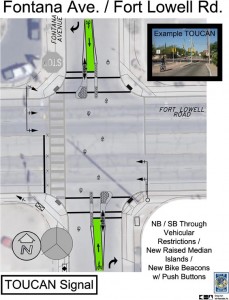
The City of Tucson is planning to convert an existing pedestrian signal along the Fourth Avenue/Fontana bike boulevard, into a newly redesigned bike-friendly crossing signal.
The city will start construction on the bike boulevard in the next few months and has created a plan to convert the existing HAWK signal at Ft. Lowell Road and Fontana Avenue into a modified TOUCAN, which allows both pedestrians and bicycles to easily cross the street.
Unlike the old TOUCAN signals, cyclists will not ride through the center median once they’ve crossed the intersection. Instead, riders will merge directly into the traffic lane. Because the median is not as large, it makes it easier to add the signal to smaller streets and doesn’t require rebuilding curbs, which costs about $200,000.
“You pull up into the area, you activate the signal, you ride through,” Tom Thivener, the City of Tucson’s bicycle and pedestrian program manager said. “Instead of having the separated bike lane, you merge with traffic.”
Brent Crowther an engineer with Kimley-Horn and Associates, Inc, which was contracted by the city to manage the bike boulevard project, said the new TOUCAN design separates the pedestrians and cyclists when they are crossing the intersection.
“With all the existing TOUCANs, the bicycles and pedestrians cross the intersection though the center,” Crowther said. “This one the pedestrians will actually be crossing outside at the the curb line, exactly where they cross with the HAWK.”
Thivener said the existing lights on the signal at Ft. Lowell will come down and will be replaced with traditional red, yellow, green lights and provide cyclists with more time and security when crossing.
Lastly, Thivener said they will hang large signs from the signal marking that the street is a bike boulevard.
“We are going to be installing these pretty big bike boulevard signs, kind of like announcement signs, that will hang over the intersection,” Thivener said. “It will basically remind motorists that this is a bike boulevard that they are crossing.”
The conversion of the HAWK to the newly designed TOUCAN will cost $90,000 – $150,000.
Crowther said the new TOUCAN built at an intersection without any signal would cost $250,000. The old style that have already been installed at several intersections across the city would cost $450,000 to construct.

[…] signals can be converted into TOUCAN signals, which provide facilities for both bicyclists and pedestrians. The trouble, […]